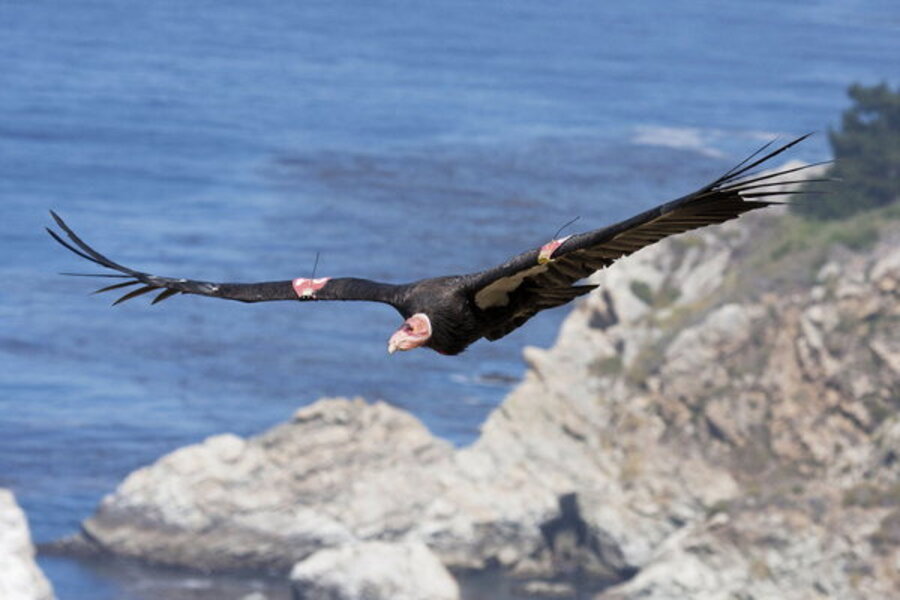Lead shot OK'd for federal lands: what does that mean for conservation?
Loading...
Ryan Zinke added a few Old West touches to his first day as secretary of the Interior. After riding to his Washington, D.C., office on a horse Thursday morning, the lifelong Montanan voiced concerns “about hunting and fishing becoming activities for the land-owning elite.”
To protect pioneers of more modest means, he then revoked a ban on lead ammunition and fishing tackle on federal lands. Gun-rights and sportsmen groups said that the ban – introduced on the Obama administration’s last full day in office – would have forced them to buy more expensive steel or copper bullets.
But with an estimated 20 million wild animals dying each year from lead poisoning, and with more than 500 million of America’s nearly 700 million hunting-approved acres under some kind of federal jurisdiction, environmentalists are crying foul.
“The revoked order would have stopped the needless, incidental poisoning of wild animals by toxic lead ammunition and fishing tackle on more than 150 million acres managed by the U.S. Fish and Wildlife Service,” Wayne Pacelle, the president and chief executive officer of the Humane Society of the United States, told the Huffington Post.
Secretary Zinke’s order threatens to set back a decades-long effort to get lead shot out of America’s backcountry, advocates say. But that shift may have already gone far enough to continue without federal support.
From an ecologist’s perspective, a hunt doesn’t end with a successful kill. A single bullet can split into hundreds of fragments on impact, Kelly Sorenson, the executive director of central California's Ventana Wildlife Society, told The Christian Science Monitor in 2014.
Some of those fragments litter the ground, leaving lead to leach into soil and water, where it can work its way up the food chain and poison waterfowl. If the shooter doesn’t collect his or her kill, or leaves guts behind, any scavengers that come along could easily ingest lead.
That’s spelled trouble for one of America’s most iconic endangered species: the California condor. “Conservationists are working against the specter of an ‘epidemic’ level of lead poisoning” in the birds, LiveScience reported in 2012. “A tally of 1,154 blood samples taken from 150 birds between 1997 and 2010 found that each year 50 percent to 88 percent exceed the ‘safe’ threshold for blood lead levels.”
After concerns about lead contamination first emerged in the 1970s, environmentalists and sportsmen joined forces to address the problem. In 1984, the Monitor’s Warren Richey reported:
The National Wildlife Federation (NWF), the nation's largest conservation group and a pro-hunting organization, has petitioned the US Fish and Wildlife Service for an immediate ban on the use of lead shot in six counties in Midwestern and Western states in an effort to protect eagles and waterfowl from lead poisoning.... The group is also calling for the establishment of similar nontoxic-shot zones in 89 other areas nationwide by next year.... Lead poisoning became a major issue in the hunting community in the mid-1970s , after a federal study estimated that between 1.6 and 2.4 million waterfowl died annually from swallowing lead shot.
The FWS answered the hunters’ petition in 1991, with a ban on the use of lead shot for waterfowl. That effort has paid off in the decades since, according to the FWS's Ken Richkus. “We’re looking at about a million to a million and a half ducks a year, in general, that do not die from lead poisoning due to the ban on lead shot,” he told Wildfowl magazine in 2011.
California lawmakers hoped to see similar results with the condor when they approved a statewide ban on lead shot, set to take effect in 2019. The Obama administration’s ban on lead munitions gave conservationists further reason to celebrate.
But, as explained in a 2008 report, these regulations sparked opposition from hunters who claimed that nontoxic rounds cost more and killed less effectively than lead bullets. Gun-rights groups supported them in their larger push against regulations.
After Zinke revoked the ban, the National Rifle Association’s Chris Cox thanked him “on behalf of the five million members of the NRA and tens of millions of American sportsmen.” Even the National Wildlife Federation, an early pioneer on this issue, criticized the Obama administration’s last-minute ban, the Huffington Post reported, saying it would be better to find a solution through more collaboration.
But for many conservationists, Thursday's order marks a setback. And with states needing to gain Congressional approval to administer their federal lands, further trouble could lie ahead for California’s efforts to save its condors.
But the anti-lead campaign still has plenty of momentum. The same 2008 report on the history of lead poisoning found that the FWS's ban was followed by industrial innovations to develop high-qualify nontoxic shotshells.
A separate study, conducted in 2012 by a researcher at the Royal Swedish Academy of Sciences, found that “There is no major difference in the retail price of equivalent lead-free and lead-core ammunition for most popular calibers [sold in the US and Europe]. Lead-free ammunition has set bench-mark standards for accuracy, lethality, and safety.”
It's not just "land-owning elites" who could adopt cheap, accurate bullets, advocates say. And the groups that opposed Obama's ban may still be willing to get behind lead-free ammunition, if they feel they are included in the process.
“Having less lead in the water and soil is better for wildlife,” Collin O’Mara, the National Wildlife Federation’s president and chief executive officer, told the Huffington Post. “But the best way to do this is not through a policy in the last few days of an administration but to have a science-based collaborative process with sportsmen and states that comes to a solution.”
“I think most sportsmen want the same outcome,” he continued, “which is healthier wildlife, but the question is the best way to get there to make sure that the outdoor experience isn’t harmed in the short term.”






